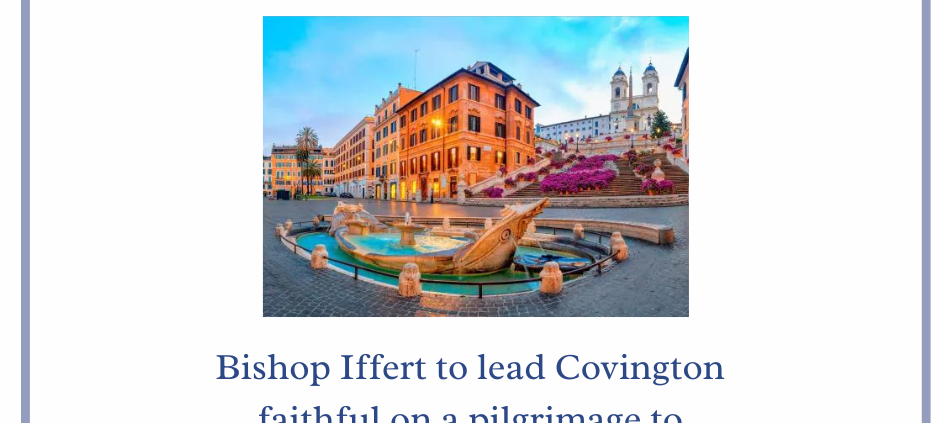Bishop Iffert to lead Covington faithful on a pilgrimage to Rome during the jubilee year
Bella Young
Multimedia Correspondent
“You shall treat this fiftieth year as sacred. You shall proclaim liberty in the land for all its inhabitants. It shall be a jubilee for you, when each of you shall return to your own property, each of you to your own family.” (Leviticus 25:10)
The first mention of jubilee in the Bible is found in Leviticus — one of the five Books of Moses. Pope Boniface VII proclaimed the Church’s first ordinary Jubilee in 1300, with the intention for a Jubilee year to be celebrated every 100 years. Responding to requests to celebrate a Jubilee earlier, the second Jubilee was held 50 years later. The years between jubilees fluctuated until 1470 when Pope Paul II issued a Papal Bull fixing the Jubilee for every 25 years. The year 2025 will be the 28th jubilee year the Church has celebrated.
‘The practice of the jubilee year was originally meant as a time of “forgiveness and restoration of freedom from servitude and debt.” Bishop Iffert explained that though this was the original intention of the jubilee year there is not such a need for the everyday person to forgive someone of servitude or debt. The general spirit of forgiveness, however, remains true to this day.
“It is a time for mercy, a time of repentance, a time for being set free, a time for letting go of grudges … a time for deepening faith, seeking freedom, a time for letting God free us from grudges that we hold against one another,” said Bishop Iffert.
This theme of forgiveness and restoration is common throughout past jubilees as it is the biblically prescribed meaning of jubilee, but each jubilee has a special focus in addition to forgiveness. For the Great Jubilee of the year 2000, the theme focused on the anniversary of Jesus’ death; the theme for the extraordinary jubilee year of 2015 was mercy, and the theme for the 2025 jubilee year, as announced by Pope Francis, is Pilgrims of Hope.
“The focus by choosing that theme,” Bishop Iffert said, “the Pope has brought that tradition of pilgrimage together with the tradition of the jubilee year.”
It is the spirit of being pilgrims that the Diocese of Covington will be hosting a pilgrimage to Rome during the jubilee year. From October 22–30, Bishop Iffert will be leading a group of faithful from the diocese to Rome, living out the theme of jubilee year, Pilgrims of Hope.
During the pilgrimage, stops will include major historical sites such as the Holy Stairs, the tomb of St. Paul the Apostle, the catacombs underneath the church of St. Sebastian and the Sistine Chapel.
“There is something about an experience like that,” Bishop Iffert said, “where you come to incorporate that into your being — not just in an intellectual way, but in a bodily way … you stand in that space and that experience of that moment becomes part of your body. You can remember the smell of the air in that place, you can remember what it was like to be with others in that place and that is part of what fuels our hope.”
For those unable to spare nine days away from everyday life for a pilgrimage to Rome, the diocese is organizing several local pilgrimages, giving everyone the opportunity to be pilgrims of hope.
Visiting these historical sites reaffirms the message of hope says Bishop Iffert. “Hope is a kind of certainty, a kind of way of knowing. To be on a pilgrimage that way means we are going to rehearse living these nine days of our lives that way and allowing our confidence in our hope to be strengthened by remembering the places, letting those places help us to remember what God has done for us through people like St. Paul. It will allow us to have that sense of trust and belief.”
To learn more about the Jubilee year and the 2025 pilgrimage to Rome go to covdio.org/jubilee.



